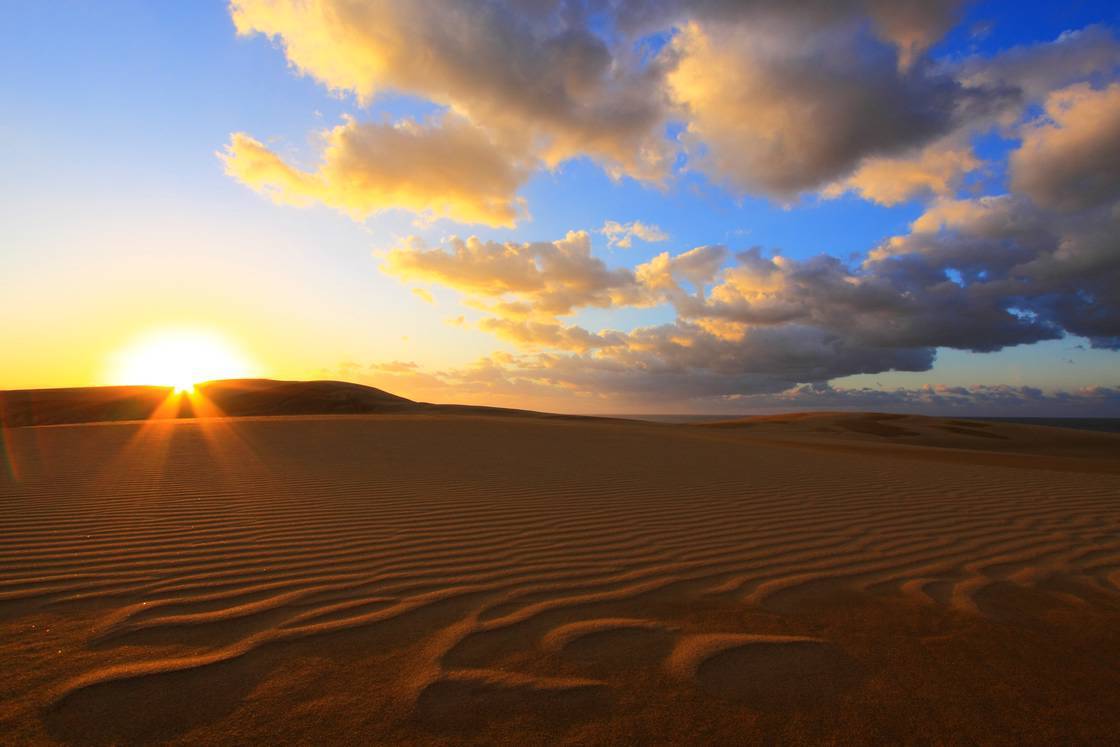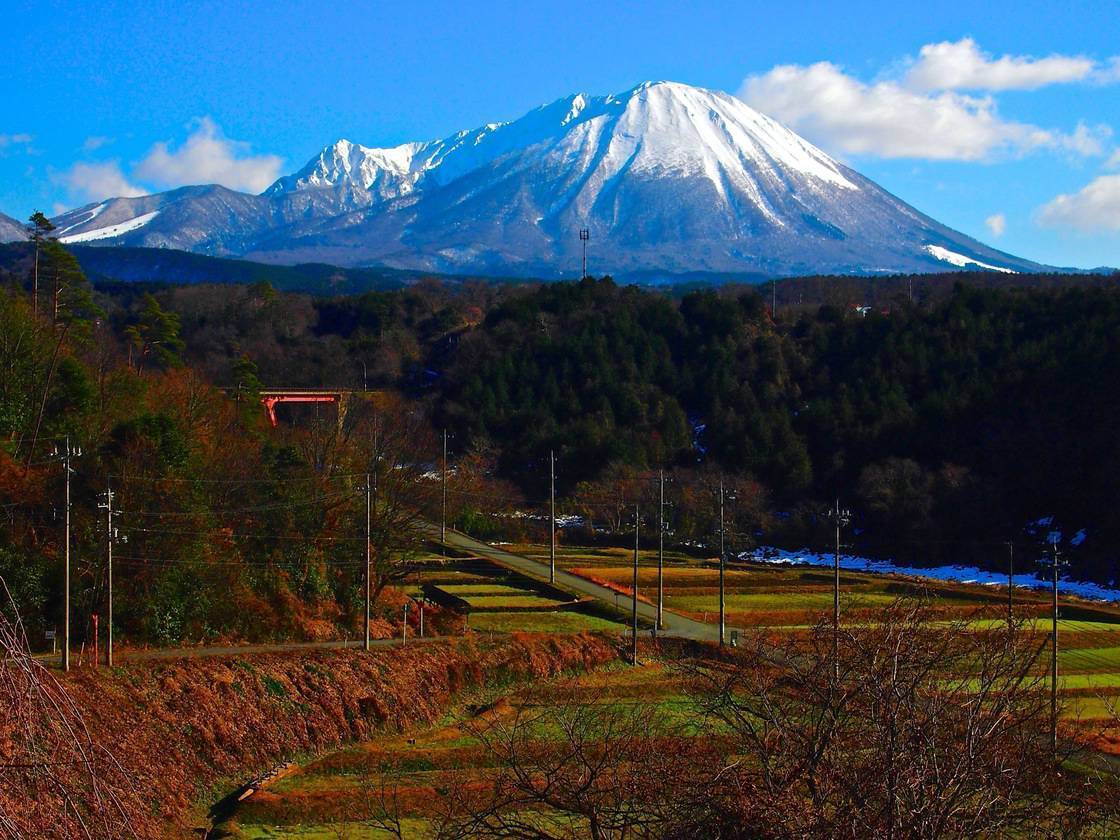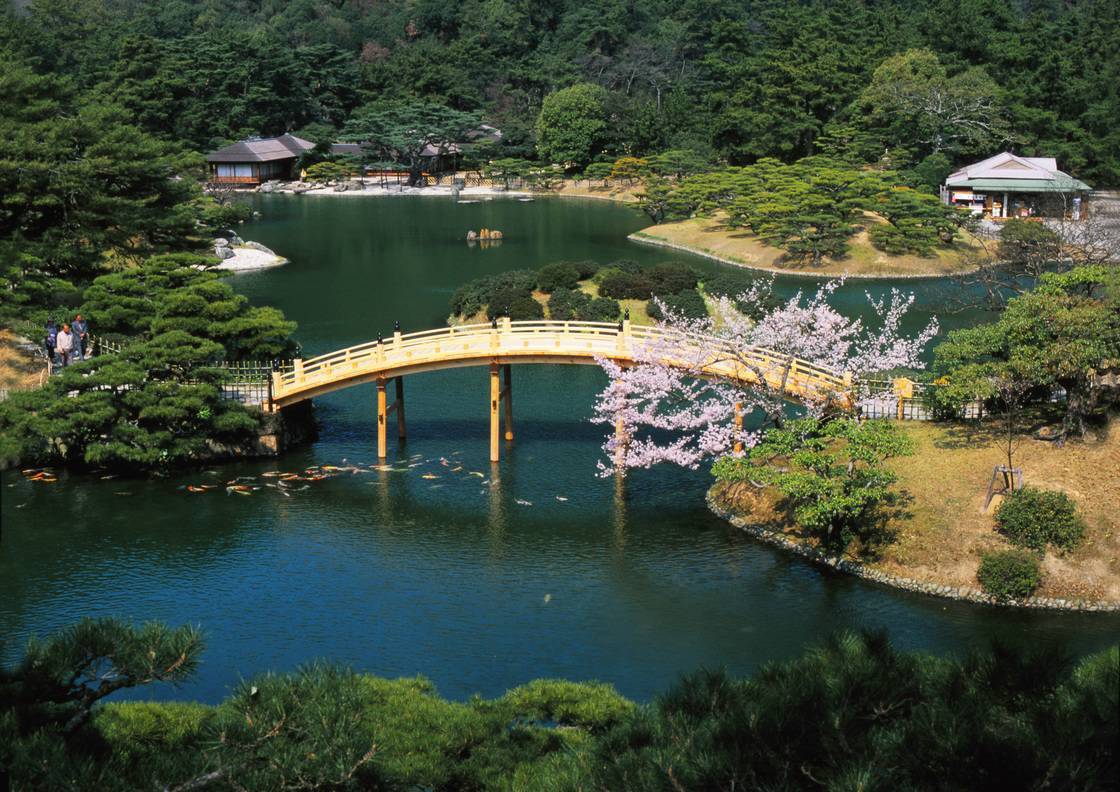Embark on the "Golden Route to West Japan" in Search of Unseen Landscapes
The "Golden Route to West Japan" is a fascinating travel route that connects the metropolis of Osaka to the scenic island of Kyushu. Once you arrive at a major station on the Shinkansen, take a trip a little further out to the land beyond. In fact, local trains and local buses that connect to the Shinkansen network provide an efficient and comfortable way to travel between cities.
There are many beautiful places in West Japan that are not well-known. As you follow the "Golden Route to West Japan," you'll discover landscapes that people have cherished and carefully preserved over generations.

In this article, we will introduce you to some of the fascinating spots along the "Golden Route to West Japan," from the fantastically beautiful sand dunes, to the mountains of faith that have been protected throughout the ages, to buildings that convey history, to contemporary art museums that blend into the local landscape. Discover Japanese landscapes you've never seen before.

The Sand Museum (Tottori Sand Dunes) will overwhelm you with the dynamism of the sand sculptures and sand dunes
The Sand Museum, located in a corner of the Tottori Sand Dunes, is the world's only museum specializing in sand sculptures. Sand sculptures are sculptures made entirely of sand and water. The theme changes every year and the museum exhibits the world's finest sand sculptures created by sand sculptors from around the world.
When you step into the exhibition room on the second floor, you will be overwhelmed by the dynamism of the sand sculptures. And if you look closely at the details, you will be left in amazement at the intricacy of the shaping.
Sand sculptures are difficult to preserve or transport, so they will have no choice but to return to sand once the exhibition is over. The giant sand sculptures are not only dynamic, but also have a fleeting beauty that can only be experienced here and now.
Once you have fully enjoyed the exhibitions at the Sand Museum, head outdoors to the observation plaza. From here, you can see the majestic Tottori Sand Dunes and the Sea of Japan beyond it.
The Tottori Sand Dunes also offers a wide range of activities, including paragliding, which allows you to stroll through the air above the dunes, and sandboarding, which allows you to slide down the slopes of the dunes. The ground is sandy, so it is safe even for beginners. Give it a try!
From spring to autumn, we also recommend "sand dune yoga." Bask in the morning or evening sun, or relax under the starry sky, and immerse your entire body in the power of the everlasting Tottori Sand Dunes.


Mt. Daisen: A healing journey interwoven with nature and faith
Mt. Daisen is a sacred mountain in Japan where the gods have long been believed to dwell. In "Izumo no Kuni Fudoki," compiled about 1,300 years ago, it is already described as "the oldest sacred mountain in Japan." It is home to one of the largest virgin beech forests in West Japan, and people have protected the nature and customs of Mt. Daisen through their devotion to the Jizo - bodhisattva or guardian deity depicted as monks and made into stone statues found along paths.
Rain and snowmelt stored in the beech forests, also known as "green dams," pass through underground layers of soil and rock over many years, producing delicious, mineral-rich water. This natural water flows down the river into the sea, creating rich fishing grounds and, combined with the andosols (dark-colored soil found in volcanic areas) at the foot of Mt. Daisen nurtures delicious mountain and sea produce.
Mt. Daisen is not only an object of prayer, but also a source of various blessings, which is why locals call it "Daisen-san" out of gratitude and affection. Mushrooms, wild plants, vegetables, fruits, and even Tottori wagyu beef are the results of the water, forests, and soil of Mt. Daisen. It is all "thanks to Daisen-san" that they can enjoy the finest ingredients such as Matsuba crab and raw tuna.
The "Daisen beech forest walk" is a tour that allows you to experience the nature and faith of Mt. Daisen. With an English-speaking guide, explore the beech forest and Ogamiyama Shrine to experience the connection between Mt. Daisen's nature and its wildlife. Then, at the temple lodgings that still remain today, visitors can enjoy vegetarian cuisine made only with plant-based ingredients while appreciating the blessings of Mt. Daisen, and calm their mind and body. It is sure to be a spiritual experience that will change your outlook on life.


"Okayama Korakuen Garden" preserves the scenery of the Edo period, "Okayama Castle"
Okayama Korakuen Garden is a prominent feudal lord garden from the Edo period, construction of which began around 300 years ago. Designated as a Special Place of Scenic Beauty by the national government, it is one of the Three Great Gardens of Japan, along with Kanazawa's Kenrokuen Garden and Mito's Kairakuen Garden. Okayama Korakuen Garden has been awarded three stars in the "Michelin Green Guide Japan."
Okayama Korakuen Garden is so spacious that it is hard to believe that it is located in an urban area. There are many historic structures throughout the garden, including Enyo-tei House, which is the feudal lord's living room, a Noh stage, and a teahouse. The garden's landscaping techniques, which make it appear spacious and three-dimensional, include a pond, an artificial hill, and borrowed views of Okayama Castle.
Although some of the buildings were lost in the war in 1945, they have been restored to look much the same as they did in the Edo period. Some of the crop fields and tea plantations that existed when the park was built still remain, allowing you to enjoy the same scenic views as those enjoyed by successive feudal lords.
Another attractive feature is that you can enjoy the beauty of the Japanese garden no matter when you visit. Flowers bloom from season to season, and seasonal events are held every month, including the Early Spring Festival, the Otaue Rice Planting Festival, and the Harvest Moon Viewing Ceremony.
If you would like to know more about the history of the garden and viewing points, please make use of our brochures (available in English, French, Korean, Traditional Chinese or Simplified Chinese), audio guides (available in English, Korean, Chinese, French) and multilingual guides.


Kibitsu Shrine is magnificent shrine building that is a masterpiece of shrine architecture
Kibitsu Shrine is a large shrine where visitors can appreciate several historically valuable structures, including the Main Hall and Worship Hall, both national treasures, as well as Important Cultural Properties and Prefectural Cultural Properties. The date of its founding is not certain, but one theory places it in the late 4th or early 5th century, during the reign of Emperor Nintoku.
The approach to the shrine, which begins immediately after exiting JR Kibitsu Station, is lined with magnificent pine trees, and a feeling of freshness and sanctity increases as you approach the shrine grounds. After climbing the stone steps and passing through the Kitazuijinmon Gate, an Important Cultural Property, you will come across the Main Hall and Worship Hall, both of which are designated as national treasures.
The Main Hall and the Worship Hall are built in the architectural style called "Hiyoku Irimoya-zukuri style," and are more than twice the size of Izumo Taisha. It burned down twice in the past, but was rebuilt in 1425. Since then, only some of the pillars of the worship hall have been dismantled and repaired. For nearly 600 years, it has maintained the same majestic appearance as when it was rebuilt. The exterior, with its two interconnected roofs, is majestic and beautiful, evoking a sense of long history.
The 360-meter-long corridor is also a must-see. It is built in a straight line on the natural terrain, and the tiled roof that extends far beyond is breathtaking. There are many other things to see. Make use of the multilingual guide maps and digital signage to visit the 600-year-old ginkgo tree and small shrine.


Ritsurin Garden is a Japanese stroll garden with variety
The defining feature of Ritsurin Garden can be summed up in one phrase: "One step, one view." This is said because every step offers a different view. There are many points of interest to admire in the vast grounds, including six ponds, thirteen artificial hills, a large tea house built in the Sukiya-zukuri style, and 1,400 pine trees, and it was awarded three stars by the "Michelin Green Guide Japan" as a place "worth a special journey."
Ritsurin Garden is one of the largest Japanese stroll gardens designated as a national Special Place of Scenic Beauty. It has a history of about 400 years. The views are spectacular no matter which route you take, but we recommend the "South Garden Recommended Course." Visitors can appreciate and experience "Hirai-ho Hill," the best viewpoint in the park, "Kikugetsu-tei Teahouse," where you can enjoy powdered green tea and Japanese sweets, and "Nanko Pond Wasen Boat Ride," where you can experience the beauty of the garden from the pond.
Check out the history and sights, and explore as much as time allows. Ritsurin Garden offers the following services for overseas visitors:
Volunteer guides (10+ English speaking guides available, as well as a few speaking Chinese, Korean and French). Please note, reservations must be made one week in advance. In some cases, we may not be able to fulfill your request due to the absence of a guide in your preferred language.
A park walking map is offered in English, Simplified Chinese, Traditional Chinese, Korean, French, Spanish and German.
A display board shows information in English. Information boards with QR codes at various spots offer English audio and text, or Simplified Chinese, Traditional Chinese, Korean, French, Spanish, German with audio only.
Free Wi-Fi is available in the park in 11 languages.
Ticket vending machines offer English, Simplified Chinese, Traditional Chinese or Korean support, and support cashless payments.


Yashima is a place with spectacular views of Setouchi and historical heritage
Yashima is a table-shaped highland located northeast of Takamatsu City, Kagawa Prefecture, overlooking the Seto Inland Sea. From the top of the mountain, the view of the islands in the calm Seto Inland Sea is truly spectacular. The evening and night views are especially wonderful, and it has been selected as one of the "100 Best Sunsets in Japan," "100 Best Night Views," and "100 Best Moons in Japan."
Yashima is home to many ancient ruins, historical sites, and ancient temples. The oldest remains is the ancient tomb called "Nagasaki no Hana Kofun", which was built around the beginning of the 5th century. Other valuable historical sites include the remains of "Yashima Castle" built in 667, "Yashima-ji Temple" built in 754, and the old battlefield of the "Battle of Yashima" (1185), one of the most important battles in the so-called "Genpei War."
Shikoku Mura Museum, located at the foot of Mt. Yashima is also recommended. This is an open-air museum of 33 old private houses from the Edo to Taisho periods that have been relocated and restored. You can get a close-up look at the houses that common people actually lived in and the tools they used at the time. You will be able to experience the daily lives of ordinary people that certainly existed there, even if they were not recorded in history.
Yashima offers the following services for overseas visitors. Be sure to explore the area and find some of the other fascinating spots we couldn't introduce here.
Brochures in English, Simplified Chinese or Traditional Chinese are available for download from "Gallery" on the official website.
Audio guides in English, Chinese, Korean, and Khmer are available on the app "ON THE TRIP"
Audio guides in English, French, Chinese and Korean are available at the "Shikoku Mura Museum"


"COMICO ART MUSEUM YUFUIN" is a contemporary art museum blending into the landscape of Yufuin
COMICO ART MUSEUM YUFUIN is a contemporary art museum that opened in 2017. Designed by architect Kengo Kuma, logo design by Kenya Hara. In 2022, a new wing will be completed, exhibiting 46 works by seven artists, including Takashi Murakami, Hiroshi Sugimoto, Yayoi Kusama, and Yoshitomo Nara. If you love art, just looking at this lineup may pique your interest.
The exterior walls are made of burnt cedar planks and the building is designed with a series of small roofs to blend in with the surrounding scenery. It blends beautifully with the nature of Yufuin and gives off a different impression with each season. "Your Dog" by Yoshitomo Nara, exhibited outdoors against the backdrop of Mt. Yufu will look different from time to time.
On the premises, there is a hot spring accommodation facility called COMICO ART HOUSE YUFUIN which can be rented out as a whole building. This building was also designed by Kengo Kuma. The two one-story buildings, named "Tsuchi" (earth) and "Take" (bamboo) are rustic yet sophisticated. Spend a special time soaking in the gentle, non-irritating hot springs of Yufuin.
COMICO ART MUSEUM YUFUIN offers free multilingual audio guides. Please bring your own earphones.


Mt. Yufu is a beautiful mountain with two peaks
Mt. Yufu is a famous 1,583-meter-high peak located in the northeast of the Yufuin Basin, and is also called "Mt. Fuji of Bungo." Its defining feature is the twin-peaked summit, with peaks to the east and west. Its majestic appearance has led to it being revered as a mountain inhabited by gods since ancient times, and it appears in the "Bungo no Kuni Fudoki" and "Man'yoshu."
In June, the Miyama Kirishima flowers paint the mountainside pink, in autumn you can see autumn leaves, and in winter you can see frost, making it a popular spot for hikers all year round. Every year around March, the fields are burned, turning the foothills completely black, but thanks to the burning, the grasslands are covered in the color of light green from spring to summer, creating a beautiful contrast with the blue sky.
If it's your first time climbing Mt. Yufu, we recommend the "Main Trailhead Route." It takes about 2 hours and 30 minutes from the "Main Trailhead" to the summit. When you reach Matae, where the two peaks split, head straight for the eastern peak. The route to the west peak is a more difficult course that involves climbing the rock's surface. The summit commands a panoramic view of the city of Yufuin, Beppu Bay, and the Kuju mountain range.
If you want to enjoy not only the nature of Mt. Yufu but also its food, join the "Experience tour of the pastoral fields at the foot of Mt. Yufu." This guided tour includes lunch made using local ingredients. Tour guides will explain the secrets of maintaining the grasslands of Mt. Yufu. If you wish to have an English-speaking guide, please inquire at the time of booking.


Facility Information
The Sand Museum (Tottori Sand Dunes)
Location: 2083-17 Yuyama, Fukubecho, Tottori-shi, Tottori
Directions:
24 minutes by local bus on the Iwami/Iwai Line from Tottori Station (JR), 3-minute walk from the "Sakyu Higashi-guchi" bus stop
21 minutes by local bus on the Sakyu Line from Tottori Station (JR), 1-minute walk from the "Suna no Bijutsukan Mae" bus stop
20 minutes by local bus on the Sakyu Line from Tottori Station (JR), 1-minute walk from the "Sakyu Center Tenbo Dai" bus stop
Mt. Daisen
Location: 45-5 Daisen, Daisen-cho, Saihaku-gun, Tottori
Directions:
From Yonago Station (JR), take the Daisen/Hongu Line of the Nihon Kotsu Bus for about 50 minutes and get off at the "Daisen-ji" bus stop
Okayama Korakuen Garden
Location: 1-5 Korakuen, Kita-ku, Okayama-shi, Okayama
Directions:
12 minutes from Okayama Station (JR), take the Okaden Bus bound for Okayama Korakuen Garden/Fujiwara Danchi, and get off at the "Korakuen-mae" bus stop
3-minute walk from Okayama Station (JR) to "Okayama Eki-mae" on the Okayama Electric Tramway, 8 minutes on the Okayama Electric Tramway
Higashiyama Line, 10-minute walk from Shiroshita Station
Okayama Castle
Location: 2-3-1 Marunouchi, Kita-ku, Okayama-shi, Okayama
Directions:
5 minutes on the tram from Okayama Station (JR) bound for Higashiyama, get off at "Shiroshita" bus stop and walk 10 minutes
Take the bus bound for Okaden Takaya or Saidai-ji via Higashiyama, get off at "Kencho-mae" bus stop and walk 5 minutes
Kibitsu Shrine
Location: 931 Kibitsu, Kita-ku, Okayama-shi, Okayama
Directions:
15 minutes from Okayama Station (JR) to JR Kibi Line (Momotaro Line), 10-minute walk from Kibitsu Station (JR)
12 minutes from Kurashiki Station (JR) on the JR Hakubi Line, 22 minutes from Soja Station (JR) on the JR Kibi Line (Momotaro Line), 10-minute walk from Kibitsu Station (JR)
Ritsurin Garden
Location: 1-20-16 Ritsurincho, Takamatsu-shi, Kagawa
Directions:
5 minutes from Takamatsu Station (JR) on the Kotoku Line (JR), 3-minute walk from Ritsurinkoen-Kitaguchi Station (JR)
8 minutes from Takamatsu Station (JR) on the Kotoku Line (JR), 20-minute walk from Ritsurin Station (JR)
3-minute walk from Takamatsu Station (JR) to Takamatsu-Chikko Station (Takamatsu Kotohira Electric Railroad), 7 minutes on the Takamatsu Kotohira Electric Railroad Kotohira Line, 10-minute walk from Ritsurin-Koen Station
19 minutes from Takamatsu Station (JR) by Kotoden Rainbow Loop Bus, 4-minute walk from the "Ritsurin Koen-mae" bus stop
Yashima
Location: 1784-6 Yashima Higashimachi, Yashima, Takamatsu-shi, Kagawa
Directions:
16 minutes from Takamatsu Station (JR) on the Kotoku Line (JR), and get off at Yashima Station (JR)
5-minute walk from Takamatsu Station (JR) to Takamatsu-Chikko Station (Takamatsu Kotohira Electric Railroad), 5-minute ride on the Takamatsu Kotohira Electric Railroad Kotohira Line or Nagao Line, 15-minute ride from Kawaramachi Station on the Takamatsu Kotohira Electric Railroad
Shido Line, and get off at Yashima Station
COMICO ART MUSEUM YUFUIN
Location: 2995-1 Kawakami, Yufuincho, Yufu-shi, Oita
Directions:
15-minute walk from Yufuin Station (JR Kyudai Main Line)
Mt. Yufu
Location: Yufuincho, Yufu-shi, Oita
Directions:
From Yufuin Station (JR Kyudai Main Line), take the Kamenoi Bus Yufuin Line for about 15 minutes and get off at the "Yufu Tozanguchi" bus stop
